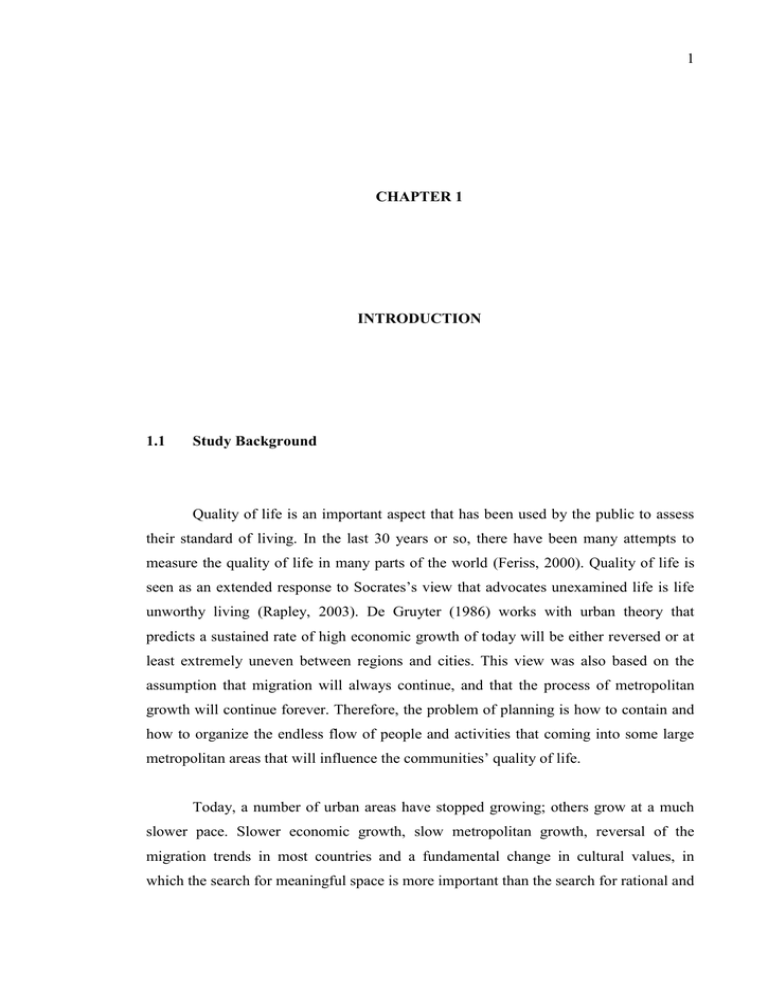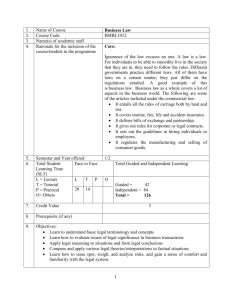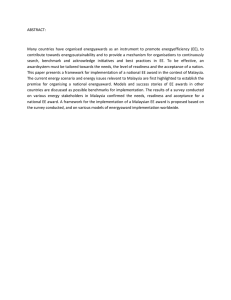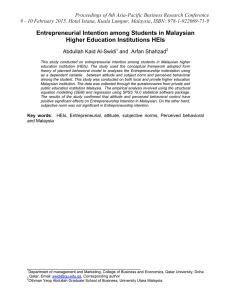1 Quality of life is an important aspect that has been... their standard of living. In ...
advertisement

1 CHAPTER 1 INTRODUCTION 1.1 Study Background Quality of life is an important aspect that has been used by the public to assess their standard of living. In the last 30 years or so, there have been many attempts to measure the quality of life in many parts of the world (Feriss, 2000). Quality of life is seen as an extended response to Socrates‟s view that advocates unexamined life is life unworthy living (Rapley, 2003). De Gruyter (1986) works with urban theory that predicts a sustained rate of high economic growth of today will be either reversed or at least extremely uneven between regions and cities. This view was also based on the assumption that migration will always continue, and that the process of metropolitan growth will continue forever. Therefore, the problem of planning is how to contain and how to organize the endless flow of people and activities that coming into some large metropolitan areas that will influence the communities‟ quality of life. Today, a number of urban areas have stopped growing; others grow at a much slower pace. Slower economic growth, slow metropolitan growth, reversal of the migration trends in most countries and a fundamental change in cultural values, in which the search for meaningful space is more important than the search for rational and 2 functional urban structure (Rapley, 2003). Nevertheless, an efficiency of resources management and planning are the major concerned in ensuring adequate amenities and better quality of life of urban populations. Due to this, it is a crucial works to identify the best city performance with the best management of quality of life for its inhabitant. Through this, it will help in identifying a city that is successful and become a role model in development management towards achieving a better quality of life for other cities. This chapter will discuss on ideas and steps along this research based on these issues. It starts with identifying the research problems then formulating the research goal and objectives. It includes identifying the scope of research and discussion on designing the research instruments. 1.2 Problem Statement City is a centre of growth and development of a focus on migration. In Malaysia, the rapid urbanization of urban areas grew at a rate of 2.2% compared to rural areas at a rate of 1.6% for the period of 2000 to 2009. This process led to the increasing population concentration in urban area by 65.4% in Peninsular Malaysia and the value is expected to increase to 75% for the period 2000 to 2020 (10th Malaysia Plan, 2010). As one of the best methods has been used until now to monitor the impact of ongoing development at urban areas is the MURNInet programme. It is a medium of monitoring the urbanization process towards better urban environment. Even so, the impact of this programme is not visible by the inhabitants which involved directly in the urbanization process in helping them to create a city that is more comfortable and fulfilling their needs. In addition, there is still lack of community involvement in the planning and implementation activities. Although, the inhabitants is not the professionals who can 3 determine the direction of the city development, but they are the key entity of the urban development as they have their own opinions and perspectives on creating a comfortable and harmonious city. In other words, the „supply‟ of urban development is useless if there is no „demand‟ from the urban population itself. With this, the challenges and obstacles in planning and managing the urban area become more complex and difficult to contain and turns into an agenda that is very important in ensuring the comfort and harmony in society. And very often the focus is the decline in quality of life in urban areas and is one of the major issues that usually rise due to poor management of urban development. For a town or city to be both viable and sustainable it is necessary to provide quality infrastructure and a high quality of living environment derived from the provision of adequate housing, social facilities, urban services and safety measures. In respect of the provision of housing, the main issue is the lack of housing for the low-income group. Although the supply of housing is generally in excess of actual demand, the supply of housing for the urban poor is still insufficient as the price of these houses is beyond the reach of this group. Under the 9th Malaysia Plan (2006-2010), many low cost housing programmes such as Low Cost Public Housing Projects and Public Housing Programmes have been implemented in urban areas but to date are still unable to address the issue of insufficient low cost housing. From 1990 to 2009, about 808,000 units of affordable housing were provided to support Malaysians in need with approximately 128,000 of these built during the Ninth Malaysia Plan period (10th Malaysia Plan, 2010). The lack of housing for the low-income group has led to the existence of squatter settlements in the major cities in the country even though the number of overall poverty has declined significantly from 49.3% in 1970 to 3.8% in 2009. These squatter settlements are lacking in proper infrastructure brought about many setbacks to the urban environment including social problems such as child education, crime, drugs, delinquency and others. A survey done in 2010 showed that there were 97,260 squatter families who were yet to be relocated to permanent housing (10th Malaysia Plan, 2010). 4 In terms of social facilities, it was found that the provision of recreational areas is generally inadequate for all towns in Malaysia. Moreover, there is a problem of maintenance of facilities as well as being non-user friendly since the location and design of facilities do not take into account the needs of certain segments of the society such as the disabled, children and elderly. Vandalism of public properties also exists and leads to underutilized facilities. The rapid growth of the urban population with 65.4% of total population in Peninsular Malaysia (10th Malaysia Plan, 2010) has also increased the demand on infrastructure and utility which is beyond the capacity of the existing facilities. The development of housing and industrial areas are usually not synchronized with the capacity of utilities particularly water supply. Major cities especially those in the Kuala Lumpur conurbation frequently face the problem of interruption of water supply. The recurrence of flash floods is due to the drainage system being unable to contain surface water run-off that has greatly increased with the higher intensity of urban activities. There are facilities that could not be fully provided, as this requires planning at the regional level instead of being handled individually by local authority such as the provision of solid waste and toxic material disposal sites. Poor maintenance of infrastructure and utilities compounded by lack of coordination among the related agencies further aggravate this problem. In terms of the quality of urban services provided, it is generally beset by a low level of service incapable of fulfilling the residents‟ expectations. The maintenance of drains and rubbish collection is inefficient, giving rise to various problems such as flash floods and poor public health. However, the quality of services like the maintenance of drainage system, rubbish collection, cleaning and maintenance of public areas varies according to the capacity of the local authority that manages the respective towns. Towns under the administration of large and financially sound local authorities will obtain services of a higher quality compared to towns under smaller local authorities. Many Malaysian towns have also experienced a decline in the quality of living with respect to safety issues. The Malaysian Quality of Life Report in 2004 indicated that between 1990 and 2002, the public safety index declined by 19.9 points. On 5 average, the percentage of crimes increased from 3.8 cases in 1990 to 6.2 cases in 2002. Safety is more crucial as of late crimes like burglary and theft are more rampant. As both aspects of safety and public security are inter-related and are a prerequisite to a stable and sustainable development, it has to be dealt appropriately in order to enhance the quality of life of urban dwellers (National Urbanization Policy, 2006). Based on the statements above, three (3) main questions set the basis for this study. The research questions are: 1) What is the suitable technique to measure quality of life in a city? 2) What are the levels of quality of life in Malaysian cities? 3) What are the causes influenced the level of Malaysian cities quality of life? 1.3 Research Goal and Objectives The goal of this study is “to compare the conditions of quality of life in Malaysian cities”. Three (3) objectives set for the study are: i. To assess the urban quality of life for seven (7) cities in Malaysia ii. To rationalize the category of the selected cities in terms of high, moderate and low quality of life iii. To benchmark the findings of the study with MURNInet results for better quality of life measuring method 6 1.4 Scope The scope of the study is divided into seven (7) main areas, which are: 1.4.1 Segmentation of Study The focus of the study was based on community (city inhabitants) rather than individual perceptions of their lifestyle as the MURNInet programme developed to evaluate the Malaysian city‟s performance towards better quality of life and sustainable development. Hence, the indicators used in this study are objectives indicators under the MURNInet programme rather than subjective indicators. The literature review will discuss the interconnection between objective and subjective indicators. 1.4.2 Selection of study Cases Inventory of Malaysian cities is based on three (3) main criteria: a) Cities ranked based on Ministry of Housing and Local Government‟s list; b) Applying minimum criteria of MURNInet programme for each city; and c) Availability of data for analysis purposes. 7 1.4.3 Source of Data Data collection was based on secondary data of MURNInet programme starting from 2005 until 2009. 1.4.4 Assessing the urban quality of life from literature review The assessment focused on the theoretical perspectives of elements based on the definition of urban quality of life. Although the main evaluation was based on objective criteria, the discussion in general are based on subjective elements for better understanding on the framework of study of quality of life. 1.4.5 Inventory and assessment of the quality of the Malaysian cities The inventory and assessment was to determine the conditions or development scenarios of each selected cities. However, the assessment was based on characteristics of city with high quality of life (from the weightage survey) which meant it did not include the unique attributes of each city such as historical, functions and location. 8 1.4.6 Formulation of a certification mechanism to rank the Malaysian cities The criteria that were used in the ranking exercise are based on point of view or interview of the MURNInet officers, MURNInet standard as well as open questionnaire survey. 1.4.7 Assessing the strengths and weaknesses of the study result The benchmarking will help to identify the problems and provide better integration of both operational and results. It will enhance and coordinate each city for better urban quality of life assessment in future. 1.5 Research Methodology The research was carried out in four stages as shown in Figure 1.1. i. Preliminary Stage The preliminary stage involved the formulation and refinement of the study issues and problems, goal and objectives, followed by a literature review of the definition of urban quality of life and current study in Malaysia on urban quality of life. The preliminary stage involves face to face and telephone interviews with officers from the related agencies especially the Federal Town and Country 9 Planning Department. The purpose of these interviews is to obtain a tentative list of local authorities for the screening process to select sample of cities for the study. ii. Audit/ Analysis Second stage was the audit analysis. This stage involved the data collection and auditing of the selected cities. There are two data collection sources, the primary and secondary data. However, secondary data was the main source for this study since it was readily available in annual publications. Primary data was collected via face-to-face interview with identified MURNInet officers. The officers were from Town and Country Planning Department at selected cities as well as at the Federal Department. For secondary data, the sources were mainly from Urban Reports, Technical Reports, Strategic Planning Reports, Statistical Reports and related publications. Furthermore, MURNInet website was also the main source of data for this study. Once the data collection was completed, the audit and analysis work was done for the selected cities. For cities audit and analysis stage, it was divided into two main sections; city‟s profile and city‟s audit. The profile of city involves the general description about each city regarding the physical and economic developments. Meanwhile, for city audit, it involves 11 main components with 33 selected sub components, namely: 1) Demographic 2) Housing 3) Urban economics 4) Utility and infrastructure 5) Public facilities and recreation 6) Environment 10 7) Sociology and social impact 8) Landuse 9) Tourism and heritage 10) Transportation and accessibility 11) Finance and management (Please refer to Appendix 1 for detail descriptions) iii. Synthesis and Rating Stage three focuses on the synthesis of the main findings from the previous audit and carried out analysis. The main output from the synthesis was the rating of the cities into hierarchy of quality of life: 1) High quality of life 2) Moderate quality of life 3) Low quality of life iv. Recommendations and Conclusion Finally, the Recommendation and Conclusion Stage (Phase IV) identified improvements of MURNInet Programme and aspects that require further study. The improvements of MURNInet programme is in the form of method to transform the existing MURNInet programme in benchmarking Malaysian cities. The aspects addressed in the improvements sections are: Measurement Benchmark Further study will consist specific strengths and weaknesses to enhance the outcome and result of the study in the future. Figure 1.1 shows the research methodology for this study. 11 Research Problems and Questions Goal Objectives Theoretical Review Definition QOL Types of QOL Planning & QOL Good Indicators Indicators of QOL Measuring Methods MURNInet Programme Stage 1 Preliminary Stage Malaysian Experienced Selection of Cities Telephone Website City Status Not Applying MURNInet Data Collection Web Survey Ranking Important Components Primary Face-to-Face Interview & Telephone Interview Information about MURNInet Stage 2 Auditing / Analysis Not achieve minimum criteria for MURNInet Analysis Secondary Audit& Analysis City Profile City Audit Urban Reports Technical Reports MURNInet Website Development Plans Statistical Reports Etc. Using Weighting Method Synthesis & Ranking High Stage 3 Synthesis & Ranking Moderate Low Weaknesses Matrix Recommendation & Conclusion Benchmark study outcomes with MURNInet results Improve Measuring Method Limitation & Further Study Stage 4 Recommendation & Conclusion Figure 1.1: Research Methodology Revise Screening 12 1.6 Significance of the Study Three (3) significances of this study are: 1) Enhance planning and management This study can help related agencies especially local authorities, and Town and Country Planning Department to concentrate on certain issues in the case studies. It can also provide the necessary information to develop a working budget. The evaluation process can help them develop long-term plans. Having a long-term goal allows for better distribution of resources and provides guidance for the future. This may lead to expansion of the scope of successful services, a clearer perception of what needs to be done and a better idea on how to approach the problems. This can raise awareness in the community and mobilize new volunteers and collaborators. 2) Increase financial support The evaluation of MURNInet programme will show related agencies that they can make improvements. A clear record of success is often important to retain existing funding and to obtain additional resources. 3) Improve public understanding and support This study can also help obtaining favorable public recognition and raise awareness of this programme (MURNInet) especially about their city. A wellknown and respected group of community can easily rally support the development activities for this programme. An active base of community support provides a certain degree of recognition and leveraging with the local government efforts in enhancing the inhabitant‟s quality of life. 13 1.7 Conclusion Enhancing urban quality of life is facing a major challenge. The dynamism of urban population and environmental movement demand will push the living standard or lifestyle from one level to another. The importance to tackle and understand how the quality of urban life changes and improves becomes major issues. Identifying current urban indicators in benchmarking the cities is crucial to enhance the planning and development priority. It is hopeful that this study conducted within selected cities will help related agencies or actor/s to react and produce practical development plan for a better environment in their city.






